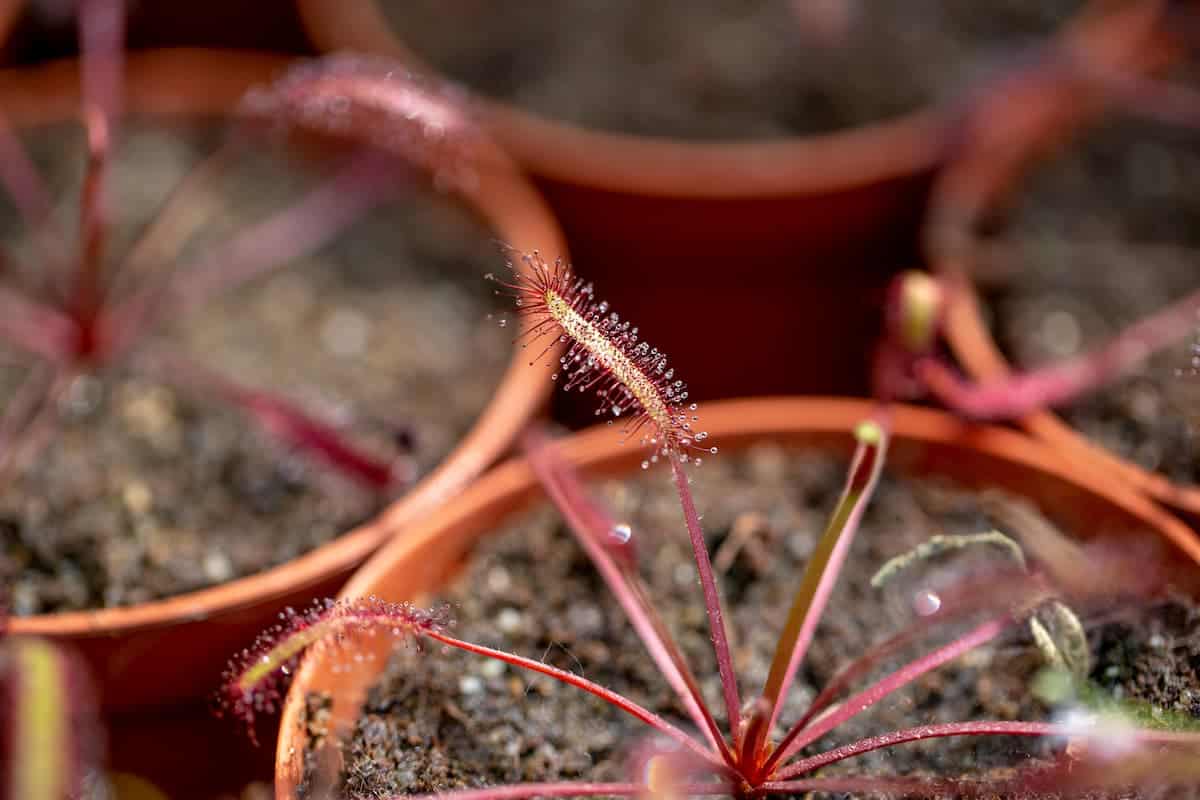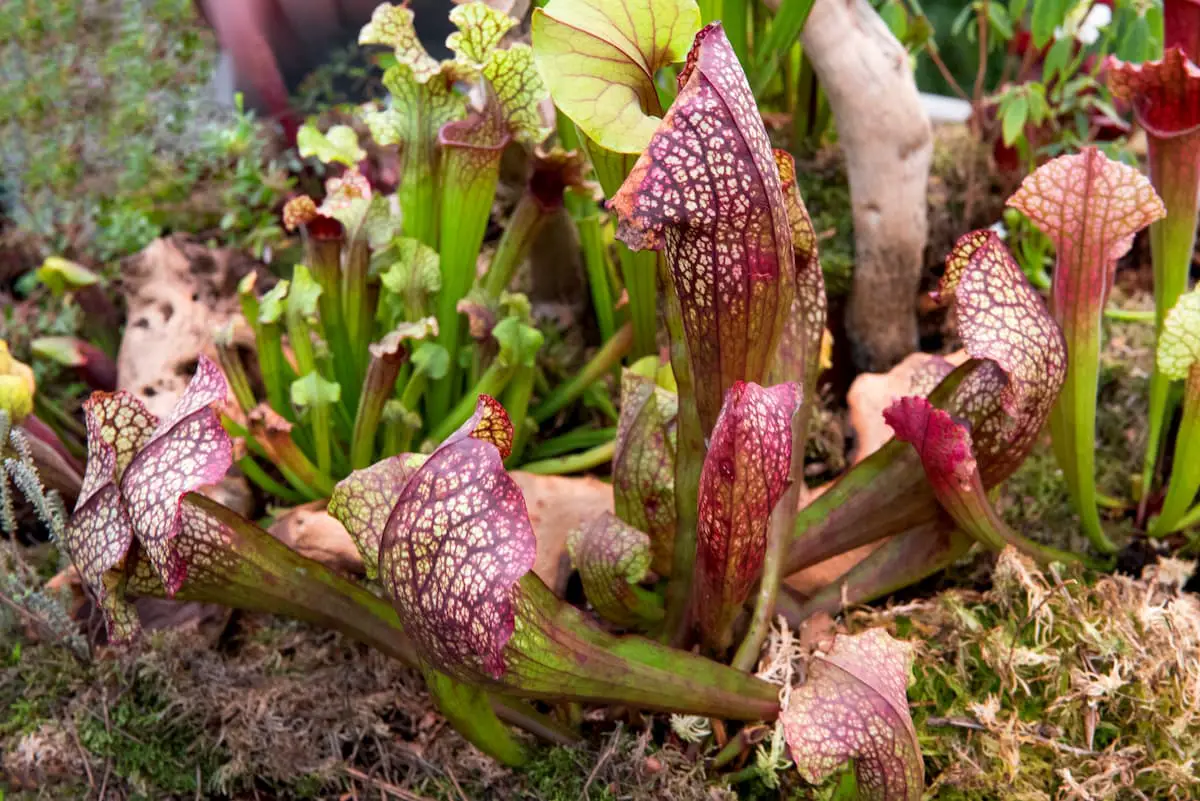With the right tools and knowledge growing Sundews indoors is a piece of cake! These are hearty plants as they are used to harsh growing conditions and are native to every continent besides Antarctica.
So grab your gardening gloves and let’s get started, in this post, we’ll teach you everything there is to know about being a successful Sundew grower.
While we’ll break down the specifics below, the best way to grow Sundews indoors is to follow these key points.
- Rinse soil
- Keep soil damp
- Keep between 58°F – 90°F
- Keep in full sun or artificial light
- Use Peat Soil or Carnivorous Plant mix
- Feed every few months
- High Humidity
- Mineral-free water
These basic steps will keep your Sundew growing strong indoors but if you want it to really thrive or if you have a species that is not tropical and more high maintenance, the tips below are very important. We’ll also discuss what different behaviors mean and what your Sundew is trying to tell you it needs!
Understanding Sundews Eating Habits
To grow a happy and thriving Sundew it’s important to know what species you’re working with. If you know what kind of plant you have, you can figure out where and how it normally grows and thrives in the wild!
The Four Key Elements of a Sundews Diet
Soil
Here we’re going to focus on their diet, as with any plant soil, water and sunlight are important but of course, there is another level to these carnivorous beauties.
As mentioned above your best bet for soil is usually a carnivorous plant mix, but if your Sundew isn’t thriving in one, it’s worth noting not all carnivorous plant mixes are created equal.
You can always make your own carnivorous plant mix tailored to your Sundew which could drastically improve growth and make care easier. Carnivorous plant mix is usually equal parts peat, sand, and perlite.
Water and Humidity
With that in mind, let’s consider the origin story of most of these fascinating leafy hunters. Most Sundews grow in tropical biomes, which means they like things sunny and wet, and they usually grow in sand and peat heavy soil.
Sundews are often also found growing with Sphagnum moss which is an excellent tip to take from nature if you’re having trouble keeping your Sundew humid enough.
Some species need more water than others, but your best bet is going to be keeping your sundew pot in a water dish that can be kept nearly always full, depending on the species.
Sundews also often prefer mineral-free water otherwise known as distilled water. You can make your own distilled water at home if you’re feeling adventurous, all you need is a double boiler, ice, and patience!
Protein
Sundews are, as you already probably know, carnivorous, but let’s dig into that a little bit more. As with most carnivorous plants, sundews eat insects to supplement the bad nutrition they usually get from the soil of the harsh climates they thrive in.
This is a bit of a double-edged sword for growing Sundews indoors as ideally, they won’t have very many insects to catch, but we can still use this knowledge to our advantage.
Since we know Sundews can supplement their nutrition, it means that soil composition (while still important) isn’t going to make or break the successful growth of a Sundew.
It also means Sundew owners have a choice to make for optimal growth, do you focus on the soil and hope it, and the occasional insect interloper will keep your Sundew well fed or do you supplement their protein intake every few months?
Luckily you don’t have to dig for this answer, your Sundew will let you know! If your Sundews start shrinking or if their leaves start curling as if they have prey but there is no prey, you’ll know they need more food.
Wingless fruit flies are often recommended, but beta fish food pellets and blood worms from any pet store will also do for those not keen on bringing bugs into the house.
When to feed your Sundew
If your Sundew is shrinking, has faded, or is curling then it’s time to feed it, and more importantly, these behaviors mean you will likely need to feed it regularly.
Easy enough to say, but what does the process actually look like? For adult Sundews, you only need to do this every few months. If you’re using beta fish food pellets or blood worms, crush them up and place the resulting powder into several traps on your plant at once.
Live insects you just need to put on the plant, the Sundew is an expert at attracting live prey so it will do the work for you!
This should encourage the Sundew to grow several new leaves. These leaves will likely be quite pale as this method encourages rapid growth that sunlight can’t quite keep up with.
After a couple of months, however, these pale leaves should make their way to a bright red, right around the time you’ll want to feed them again! If you are interested in having a brighter plant it is a better idea to feed one or two traps every few weeks instead of several traps every few months.
Keep in mind some Sundews can only use their traps a few times so if older leaves are not eating, don’t panic and try a newer one.
Growing A New Sundew Indoors
Growing Sundews Indoors From Seeds
So far, we’ve discussed how to take care of adult or semi-adult Sundews, but what if you’re starting from scratch, or from seed rather? First be aware that some Sundew seeds require cold stratification, which is a process in which you replicate a winter season indoors.
Usually this means keeping seeds in the fridge or a cold location for several months. This is why in general you’ll hear it can take 1-6+ weeks for some species to germinate, and up to 3 years for others.
If you’re growing a species that requires a cold period, the best method is to place the seeds inside of a microcentrifuge tube with less than 1 ml of distilled water and then shake and place in the fridge for however long your species specifies.
Once the cold period is over, and for species that don’t require a cold period, it’s time to “plant” the germinated seedlings! You’ll want to sprinkle the seeds onto the surface of whatever media you’ve prepared for them, likely a mix of pre-rinsed silica sand and sphagnum peat.
Rinsing the soil mixture will help you avoid mold and algae growth as Sundews like to be kept in constantly damp soil.
Do not bury the seeds or nothing will grow, it is very important to keep them on top of the soil, and if you want bigger plants spreading the seeds out will help more than clumping them together.
Sundews need a warm environment and high humidity for proper germination so placing saran wrap over the seedlings will be a great help.
Some Sundew growers will also “harden” their seedlings by poking holes in the saran wrap and slowly exposing them to less humidity over the course of a few weeks, this makes the plants more durable and prepares them for the environment they will live in as adults.
After a few weeks to a few months, you should see several small carnivorous leaves and you’ll know your Sundew is on a great path! At this point to speed their growth it is recommended they be fed crushed beta food pellets.
Growing Sundews Indoors From Cuttings
If the process of growing Sundews from seed to stalk seems a bit daunting, don’t worry there is another way to grow Sundews as well! Most species do very well growing new plants from a leaf or flower stalk cutting.
To take a leaf cutting to propagate a new Sundew you can cut a whole leaf or a portion of a leaf from an existing adult. You’ll want to take this cutting and place it in a mixture of the same soil composition the parent plant was grown in, with a lot of water.
Ideally, you’ll want to create a soupy, bog-like environment. These cuttings will need as much direct light as possible and you’ll want to keep the water level high until you start seeing small roots protruding from the cutting.
At this point, you can gradually let the water level lower until the plantlets are established and you can see roots as well as new growth.
Basics Every Indoor Sundew Grower Should Know
Sundews are a wonderful group of carnivorous plants that thrive and grow with attention and care. For plants, even carnivorous ones this means considering their soil, water, light exposure, and protein intake.
Sundews love damp soil composed of sand, peat, and occasionally live moss. Their pots should sit in a water dish with nearly always at least ¼inch of water. Sundews also like to be warm and love humidity.
While some do well in partial shade, for the best growth and vibrant colors – direct sunlight or an artificial light source are best.
Distilled water will go a long way to keep Sundews thriving and wingless fruit flies, blood worms, and beta fish food pellets are all great options to supplement protein if they are not getting enough protein from household insects.
Sundews are great communicators and will tell you what they need to thrive and grow, you just need to learn the signals!



Leave a Reply